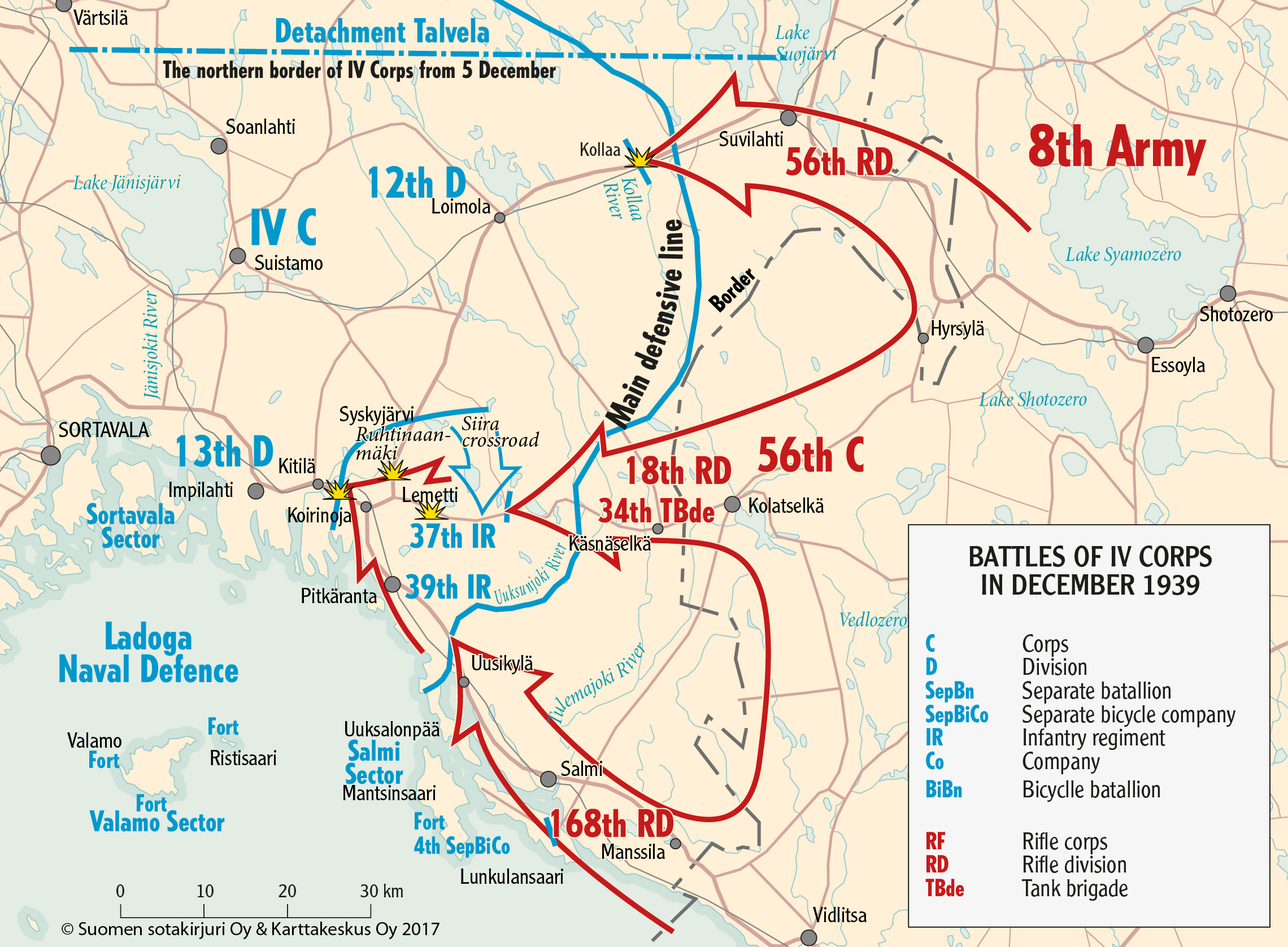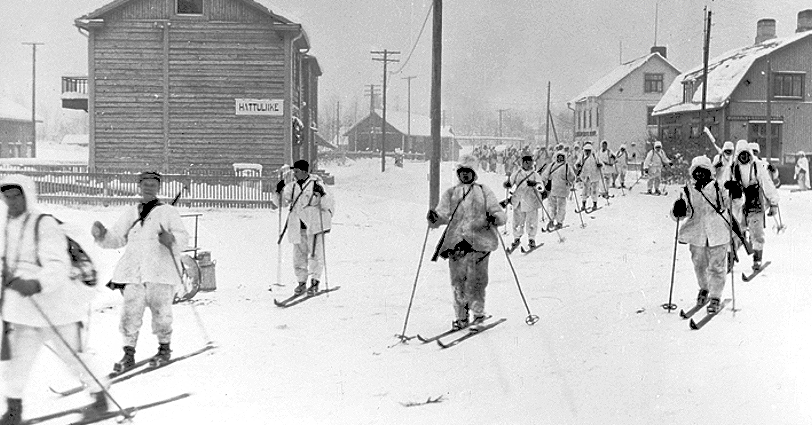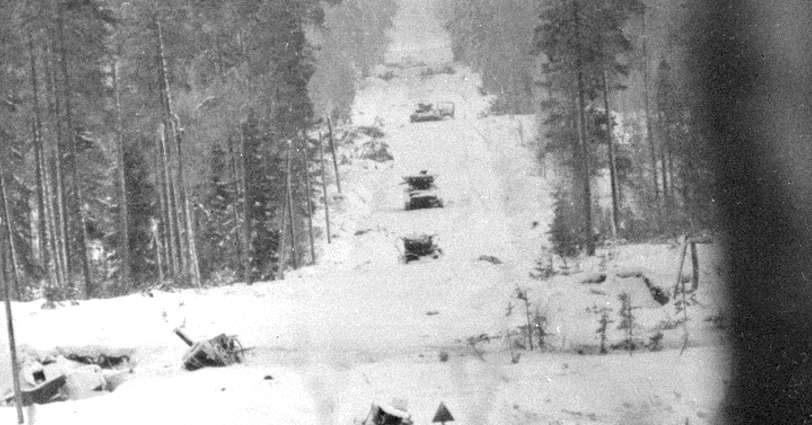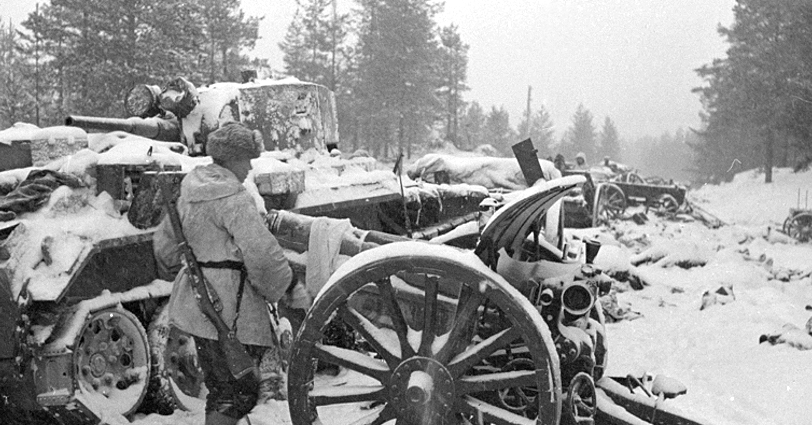Ladoga Karelia and Border Karelia
The IV Corps lost Suvilahti in the early battles. The enemy’s offensive was stopped at the Kollaa River, where Finnish forces held their positions until the end of the war. Near Lake Ladoga, the enemy advanced to the Kitilä–Lemetti–Ruhtinaanmäki line. In this area, the IV Corps blocked the enemy forces’ rear routes with encirclement attacks. Two divisions were cut off and trapped in pockets, which are known as mottis in Finnish. The troops of the first division, a rifle division reinforced with a tank brigade, were caught in several mottis. The majority of these forces were destroyed in motti battles. The second division was encircled in its entirety. This large-scale motti in Kitilä held out until the end of the war.

Edited map from the work Raunio, Ari, Sotatoimet – Suomen sotien 1939−45 kulku kartoin (Military Operations – The Course of Finnish Wars in 1939–45 with Maps). 3rd edition, Karttakeskus 2013.
The loss of the Suojärvi (Suoyarvi) area was a disappointment to the commander-in-chief
On 2 December, after the loss of Suvilahti, the central village of the municipality of Suojärvi, the commander-in-chief, Field Marshal Gustaf Mannerheim, ordered the IV Corps to launch a counterattack in all of the enemy’s areas of attack the following day. The main goal was to retake Suvilahti.

Finnish troops withdrawing via Suvilahti, the centre of Suojärvi, to the Kollaa River in the first days of December 1939. SA-kuva.
The counterattacks were unsuccessful in all areas of attack, leading to partial disorder among the troops of the IV Corps (IV C). The same day, Mannerheim appointed Jaeger Officer, Major General Woldemar Hägglund as the new commander of the corps.
Jaeger Officer, Major General Juho Heiskanen, who had commanded the corps since the additional refresher training, was reassigned to another position. Hägglund took up command of the corps on 4 December. On 5 December, the General Headquarters ordered for the area between Ilomantsi and Suojärvi and the troops stationed there to be detached from the area defended by the IV Corps. In this detached area, Detachment Talvela, which operated directly under the General Headquarters, took charge of the front. The detachment was renamed Group T on 19 December.
An attack was stopped at the Kollaa River and Kitilä (Kitelya)–Syskyjärvi (Syuskyuyarvi) line

Photo taken with a telephoto lens of the enemy’s tanks advancing along a road in Kollaa. SA-kuva.
Häggund’s corps (IV C) stopped an enemy attack at the Kollaa River and in Kitilä. After this, his forces launched a series of counterattacks in the Kitilä area. These counterattacks were not yet able to block the enemy’s rear routes in December, but they were successful in stopping an offensive by an enemy rifle corps (56th RC) for good.
The enemy’s rear routes were cut off in January
The fourth attack by the corps, launched on 6 January, led to the road following the shore of Lake Ladoga being blocked and the large-scale motti in Kitilä being formed. One of the Soviet divisions was trapped in several smaller mottis on the road between Käsnäselkä (Kyasnyaselkya) and Lemetti. The mottis in the Lemetti area encircled not only a rifle division but also a tank brigade.
Some of the pockets were destroyed in motti battles in February

Equipment left behind by an enemy column, destroyed on the road between Lemetti and Syskyjärvi. This photo was taken approximately four kilometres north of Lemetti. SA-kuva.
The large-scale motti in Kitilä and some of the mottis on the road between Lemetti and Käsnäselkä held out until the end of the war. The mottis in Lemetti were all destroyed. The forces trapped in them included command personnel of a rifle division (18th RD) and a light tank brigade (34th LTBde). Towards the end of February, the besieged Soviets received permission to launch a breakout attack. Some of the troops who broke out of the mottis made it to the Soviet side of the front line. The Red Army arrested the commander of a rifle division, Brigade Commander Georgy F. Kondratiev, who had broken out of a motti. He was executed by shooting.
The Red Army’s offensive force increased manifold in March
The Main Command of the Red Army, i.e. the Stavka, concentrated approximately ten new divisions in the area between the Kollaa River and Lake Ladoga in February and March 1940. Five of the divisions were deployed in Suvilahti, in the area of the Kollaa River, while another five were deployed near the shore of Lake Ladoga. The forces in the area of the Kollaa River remained in the 8th Army. Army Commander 2nd Rank G. M. Stern was appointed as its new commander in December.
In January, the forces operating in the area near the shore of Lake Ladoga were detached from the army’s area into the Southern Group. It was formed into the 15th Army in February, and Army Commander 2nd Rank M. P. Kovalyov was appointed as its commander. He had already served as commander of the Southern Group. Kovalyov was released from his position as commander on 25 February. He was replaced by Army Commander 2nd Rank Vladimir N. Kurdyumov, who had until then served as the army’s deputy commander.
The Stavka aimed to free the units trapped in mottis and destroy the Finnish forces. The attacks were launched in March. The Soviets took the initiative. At the end of the war, the Red Army had yet to achieve its offensive goals.
Ari Raunio

 SUOMEKSI
SUOMEKSI PÅ SVENSKA
PÅ SVENSKA по-русски
по-русски